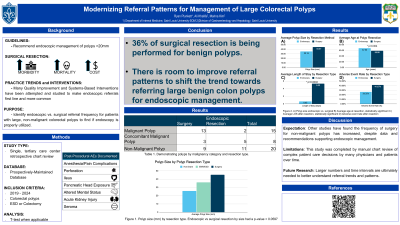Sunday Poster Session
Category: Colon
P0219 - Modernizing Referral Patterns for Management of Large Colorectal Polyps
Sunday, October 27, 2024
3:30 PM - 7:00 PM ET
Location: Exhibit Hall E

Has Audio

Ryan Plunkett, MD
Saint Louis University School of Medicine
St. Louis, MO
Presenting Author(s)
Ryan Plunkett, MD1, Ali Khalifa, MD1, Marina Kim, MD2
1Saint Louis University School of Medicine, St. Louis, MO; 2SSM Health Saint Louis University Hospital, St. Louis, MO
Introduction: Current guidelines recommend endoscopic management of colorectal polyps >20 mm. Despite this, patients with large polyps are often referred for surgical resection which is associated with higher morbidity, mortality, and costs [1]. This study intended to identify the endoscopic versus surgical referral frequency for patients with large colorectal polyps and discover associated procedural outcomes.
Methods: A single, tertiary care center retrospective chart review was conducted using a prospectively maintained database. Inclusion criteria were a diagnosis of colorectal polyps having undergone endoscopic submucosal dissection (ESD) or laparoscopic resection from 2019 to 2024. Polyps >20 mm were selected. Demographics, polyp size and location, polyp resection technique, adverse events (AEs), and length of hospital stay (LOS) were collected and categorized by final treatment modality, endoscopic or surgical.
Results: In total, we identified 27 patients (44.4% females, 48.1% black, 51.9% white). Of these, 43 applicable polyps were identified; endoscopic removal (n=19) vs surgical resection (n=24). Comparing endoscopy vs surgery, the average age was 67.5 vs 58.5 years (p=0.004), the average polyp size was 35.16 mm vs 44.67 mm (p=0.060), LOS was 0.63 days vs 5.33 days (p=0.0002), and AE rates were 26.32% vs 41.67%. Of the 24 surgical cases, 9 (37.5%) were found to be without malignant polyps.
Discussion: This study suggests there may be a notable amount of surgeries in our community for lesions that could be referred for endoscopic management. An opportunity exists for improved referral patterns which may provide safer and more cost-effective care for large colon polyps. This is not an isolated struggle, as studies have suggested the frequency of surgery for non-malignant polyps has increased [2]. This data serves as motivation to conduct local intervention to increase referral rates for endoscopic management of large polyps.
Resources:
[1] Rex DK. What can colonoscopists do now to move management of large benign laterally spreading lesions in the colorectum from surgery to EMR? Gastrointest Endosc. 2020 Jan;91(1):132-134. doi: 10.1016/j.gie.2019.09.025. PMID: 31865987.
[2] Peery AF, Cools KS, Strassle PD, McGill SK, Crockett SD, Barker A, Koruda M, Grimm IS. Increasing Rates of Surgery for Patients With Nonmalignant Colorectal Polyps in the United States. Gastroenterology. 2018 Apr;154(5):1352-1360.e3. doi: 10.1053/j.gastro.2018.01.003. Epub 2018 Jan 6. PMID: 29317277; PMCID: PMC5880740.
Disclosures:
Ryan Plunkett, MD1, Ali Khalifa, MD1, Marina Kim, MD2. P0219 - Modernizing Referral Patterns for Management of Large Colorectal Polyps, ACG 2024 Annual Scientific Meeting Abstracts. Philadelphia, PA: American College of Gastroenterology.
1Saint Louis University School of Medicine, St. Louis, MO; 2SSM Health Saint Louis University Hospital, St. Louis, MO
Introduction: Current guidelines recommend endoscopic management of colorectal polyps >20 mm. Despite this, patients with large polyps are often referred for surgical resection which is associated with higher morbidity, mortality, and costs [1]. This study intended to identify the endoscopic versus surgical referral frequency for patients with large colorectal polyps and discover associated procedural outcomes.
Methods: A single, tertiary care center retrospective chart review was conducted using a prospectively maintained database. Inclusion criteria were a diagnosis of colorectal polyps having undergone endoscopic submucosal dissection (ESD) or laparoscopic resection from 2019 to 2024. Polyps >20 mm were selected. Demographics, polyp size and location, polyp resection technique, adverse events (AEs), and length of hospital stay (LOS) were collected and categorized by final treatment modality, endoscopic or surgical.
Results: In total, we identified 27 patients (44.4% females, 48.1% black, 51.9% white). Of these, 43 applicable polyps were identified; endoscopic removal (n=19) vs surgical resection (n=24). Comparing endoscopy vs surgery, the average age was 67.5 vs 58.5 years (p=0.004), the average polyp size was 35.16 mm vs 44.67 mm (p=0.060), LOS was 0.63 days vs 5.33 days (p=0.0002), and AE rates were 26.32% vs 41.67%. Of the 24 surgical cases, 9 (37.5%) were found to be without malignant polyps.
Discussion: This study suggests there may be a notable amount of surgeries in our community for lesions that could be referred for endoscopic management. An opportunity exists for improved referral patterns which may provide safer and more cost-effective care for large colon polyps. This is not an isolated struggle, as studies have suggested the frequency of surgery for non-malignant polyps has increased [2]. This data serves as motivation to conduct local intervention to increase referral rates for endoscopic management of large polyps.
Resources:
[1] Rex DK. What can colonoscopists do now to move management of large benign laterally spreading lesions in the colorectum from surgery to EMR? Gastrointest Endosc. 2020 Jan;91(1):132-134. doi: 10.1016/j.gie.2019.09.025. PMID: 31865987.
[2] Peery AF, Cools KS, Strassle PD, McGill SK, Crockett SD, Barker A, Koruda M, Grimm IS. Increasing Rates of Surgery for Patients With Nonmalignant Colorectal Polyps in the United States. Gastroenterology. 2018 Apr;154(5):1352-1360.e3. doi: 10.1053/j.gastro.2018.01.003. Epub 2018 Jan 6. PMID: 29317277; PMCID: PMC5880740.
Disclosures:
Ryan Plunkett indicated no relevant financial relationships.
Ali Khalifa indicated no relevant financial relationships.
Marina Kim indicated no relevant financial relationships.
Ryan Plunkett, MD1, Ali Khalifa, MD1, Marina Kim, MD2. P0219 - Modernizing Referral Patterns for Management of Large Colorectal Polyps, ACG 2024 Annual Scientific Meeting Abstracts. Philadelphia, PA: American College of Gastroenterology.
